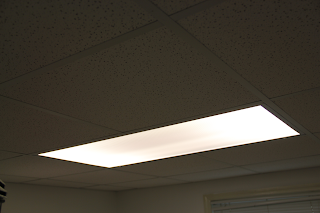| A drywall ceiling |
The above is a conventional drywall ceiling. It consists of sheets of drywall screwed directly into the joists of the floor above. This is the most common type of ceiling seen in residential homes and apartments.
 |
| Traditional suspended ceiling |
This is a suspended ceiling or drop ceiling. It is made of metal railings which form a grid suspended from the joists above by wire (between 18 and 12 gauge) with panels filling the square or rectangular spaces. This image also shows a fluorescent troffer, the most common lighting used in such ceilings. These shallow light fixtures normally hold 2 or 4 florescent tubes whose length is either 24 or 48 inches depending on whether the opening the in grid is 1 or 2 panels wide respectively. The panels used are flat, white, and have a bit of small scale texture to them. These ceilings are commonly found in commercial structures as they are not very attractive but provide good access to the mechanical systems which run through the ceiling.
| Awesomeness++ suspended ceiling |
This is another, much more awesome, suspended ceiling. Here the panels are beveled so they sit proud of the grid plane. They also have a much larger scale texture which in this case gives the appearance of naturally cloven and weathered stone.
This room makes use of indirect lighting above the bookshelves so there are no light fixtures in the ceiling. The white ports shown are vents attached to the HVAC system ducting. Other options for lighting are also available for these ceilings.
| Suspended ceiling with can lights |
Above we have another ceiling making use of can lights. These are the kind of lights you commonly see recessed into drywall ceilings. These lights can also be used in suspended ceilings. In fact the standard can lights sold at you local home center may be install into either a drywall or suspended ceiling.
Why don’t more people have suspended ceilings?
People think they are ugly.
Most people associate suspended ceilings with the dull ultra utilitarian ceilings they see in their offices. This prejudice is so intense those who see an excellent suspended ceiling will not even recognize that it is a suspended ceiling. This prevents them from acquiring counter examples to their experience.
Houses do not commonly come with them.
Installing a suspended ceiling in existing construction requires removing the existing drywall ceiling. This is a very messy process. It generates a tremendous amount of fine dust and even a small room will have so much drywall you will want to either hire someone to remove it or rent a dumpster.
It is expensive per square foot.
While you will spend less on labor to install a suspended ceiling compared to a drywall ceiling you will spend a lot more on materials. Drywall is cheap but ceiling tiles are not. Expect to spend at least triple (or more) on suspended ceiling materials compared to a drywall ceiling.
You will loose some ceiling height.
Four to six inches is the minimum distance you want between the joists and the grid of the suspended ceiling. Any less and it will be hard to place the tiles. Since drywall ceilings are attached directly to the joists this is ceiling height you will loose from the room. Recessed lights, or can lights, are taller than six inches but are normally installed between joists so their use will not force the ceiling lower. Other type of lights may so advanced planning is important.
Some of the benefits of a suspended ceiling over a drywall
ceiling.
Provides access to the space above the ceiling.
This is very important if you ever have plumbing leaks, electrical problems, need to run new cables (security camera, home theater, networking), or want to remodel. Most contractors which provide these services do not work with drywall. Thus if their work requires making holes in your ceiling (which is very often does) they will either get a subcontractor to do the work or leave it to the homeowner to fix. Drywall work is slow and requires repeated layering, drying, and sanding of drywall compound. This makes it expensive.
The tiles are removable, replaceable, and paintable.
If a tile is damaged, perhaps by gouging it with something you were not careful enough in moving, it can be easily removed and replaced.
The tiles are also easily painted with aerosol (spray) paints. Many restaurants and hotels use suspended ceilings with the tiles and grid painted in combination with crown molding to match their decor. The grid is a bit more troublesome to paint since the existing hard coating needs to be roughed up and is not normally removable once installed.
A huge variety of tiles are available.
Everything from the standard white tile to tiles made to look like stone is available. Some specialty manufactures even make metallic tiles to look like hammered tin or brass, fine cast plaster tiles, or luminescent tiles.
In the end if you are unable to get an awesome ceiling using a suspended ceiling system then you are doing it wrong.
Royal ceilings and walls Perth provides wide range of Gyprock interior Shop Fit Outs, Commercial Building Fit Outs, and Office Partitioning. Whatever you requires we can do! We also specialize in shop fit outs and office partitions.
Suspended Ceilings Perth